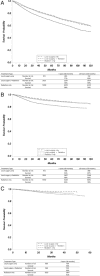Treatment and survival in 10,429 patients with localized laryngeal cancer: a population-based analysis
- PMID: 24639148
- PMCID: PMC5560918
- DOI: 10.1002/cncr.28608
Treatment and survival in 10,429 patients with localized laryngeal cancer: a population-based analysis
Abstract
Background: The objectives of this study were to identify factors associated with treatment differences, characterize changes in treatment patterns over time, and compare survival across treatment types in patients who received treatment for localized laryngeal cancer.
Methods: Using the Surveillance, Epidemiology, and End Results database, we conducted a retrospective cohort analysis of patients who were treated from 1995 to 2009 for localized laryngeal cancer. Four treatment groups were defined: (1) radiation only, (2) local surgery only, (3) local surgery and radiation, and (4) open surgery with or without radiation. Variations in treatment rates between these groups were evaluated according to demographic factors, and differences in treatment rates across time were calculated. Associations between treatment and mortality were assessed using Kaplan-Meier methods. Cox proportional hazards regression models were used to adjust for potential confounding covariates.
Results: In total, 10,429 patients with localized laryngeal cancer were identified. Most patients (57%) were treated with radiation only; 25% with local surgery and radiation, 9% with local surgery only, and 9% with open surgery with or without radiation. Race, age, and registry were associated with differences in treatment. Receipt of single-modality treatment increased and receipt of combined-modality treatment decreased over the study period. Better survival was observed with white race, younger age, and treatment with local surgery. Survival differences associated with treatment type were observed within 3 years of diagnosis and persisted beyond 5 years after diagnosis.
Conclusions: Although treatment patterns became more adherent to treatment guidelines over time, we identified survival differences associated with treatment type that warrant further investigation into treatment decision-making for patients with localized laryngeal cancer.
Keywords: End Results Program; Epidemiology; Surveillance; laryngeal cancer; operative procedures; radiation; survival; voice.
© 2014 American Cancer Society.
Conflict of interest statement
CONFLICT OF INTEREST DISCLOSURES
The authors made no disclosures.
Figures



References
-
- Hoffman HT, Porter K, Karnell LH, et al. Laryngeal cancer in the United States: changes in demographics, patterns of care, and survival. Laryngoscope. 2006;116:1–13. - PubMed
-
- Carvalho AL, Nishimoto IN, Califano JA, Kowalski LP. Trends in incidence and prognosis for head and neck cancer in the United States: a site-specific analysis of the SEER database. Int J Cancer. 2005;114:806–816. - PubMed
-
- Cosetti M, Yu GP, Schantz SP. Five-year survival rates and time trends of laryngeal cancer in the US population. Arch Otolaryngol Head Neck Surg. 2008;134:370–379. - PubMed
-
- Myers EN. Cancer of the Head and Neck. 4th. Philadelphia, Pa: Saunders; 2003.
-
- Agrawal N, Ha PK. Management of early stage laryngeal cancer. Otolaryngol Clin North Am. 2008;41:757–769. vi–vii. - PubMed
MeSH terms
Grants and funding
LinkOut - more resources
Full Text Sources
Other Literature Sources

